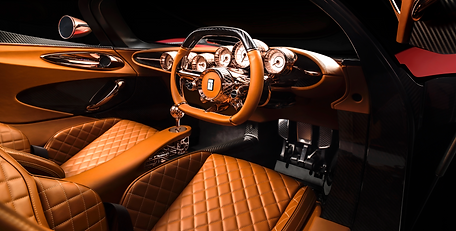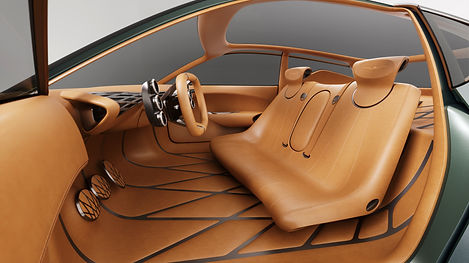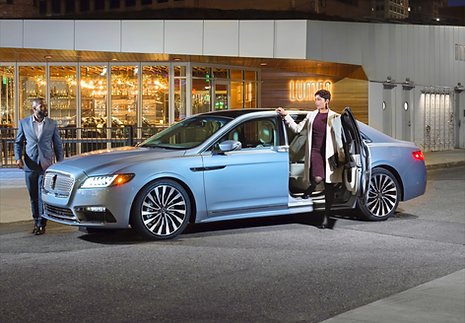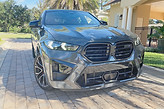The Electrified Jaguar

The Road to Design through Pebble Beach
The “Concept Lawn” at The Lodge during the Concours offers a glimpse into the future.
Automotive design can be pretty subjective. A person may like this car’s styling, but hate that other funky contraption they’re confronted with. And I constantly get car design critiques from gearhead friends about whatever new test vehicle I’m driving each week. No need for me to take it personally, after all, it’s not mine and I’ll drive something different next week.


Back in the early nineties, when electric vehicles were first timidly testing California’s roads, I received quite a different reaction. When I returned to my GM EV-1 with groceries in hand, I found a Post-it note on the windshield. Apparently, someone was so offended by the EV’s styling, he or she went to considerable trouble to share with me that “It’s the ugliest car I’ve ever seen”. I lost not a moment’s sleep over that critique, but I’m always impressed with how much passion car design can ignite.
When I evaluate new vehicles for readers, I try to be as objective as possible. I’ll share what I’ve learned about how well the vehicle meets the expectations of its intended audience. If that includes people who I caught staring in joyful ecstasy at the machine, I’m betting the designer nailed it. For example, during Monterey Classic Car Week, I followed a gaggle of the Pebble Beach Concours Tour down Carmel’s Ocean Avenue in a stunning red Rolls-Royce Dawn convertible. A group of locals had gathered with scoring signs to rate the classics. They gave my car a perfect ten and that’s a win for the RR team.
Electric Opportunity
Many of the new designs at the Concept Lawn this year were battery powered and creative style is no longer an oxymoron when applied to EVs. A perfect example is Bentley’s EXP 100 GT coupe. When my designer friend Tom Matano first looked at the classic proportions; a long hood flowing into a short greenhouse and deck, he asked if was really electric. That style shouts front petrol engine, rear wheel drive. Moreover, the big grille is a clue that a radiator might reside right behind it.
When assured that this was an EV, Tom weighed in on the design opportunities that occur when gobs of air cooling for an internal combustion engine are no longer required. Now the car’s front view is a canvas for the designer to make a statement. The design question becomes; do we create a face or go minimalist? I’m personally fond of a face like the grill the first Tesla Model S sported than its current razor-like cutting-edge style. Perhaps that’s because I’m so used to a vehicle making a brand statement.
Future Designs
My takeaways from conversations with design professionals are that new offerings are based on what objectives the automaker is after. Is the life of the new design expected to be long or short? Long lasting style like BMW’s 7-Series may not have been popular in the beginning, but it passed the test of time with flying colors as each new edition became just a bit more refined.
Another design objective might prefer drama over long shelf life. Supercars like the new De Tomaso P72 fit this high fashion category. The need to be expressive intersects nicely with the reality of hand-built, low production. If the style isn’t necessarily enduring, the bet wasn’t really that big a deal.
Out on the Pebble Beach Concours field, I asked Tom what he thought of the De Tomaso design. Tom’s quick response was that it was a bit “fat” for his taste. Fat may be a bit harsh in my opinion. I’d settle for voluptuous in Rembrandt’s fashion to best describe the supercar’s sensuous styling. And that’s the fun of automotive design, beauty is clearly in the eyes of the beholders.
On the subject of long-lasting, VW Beetles, MINI Coopers and Fiat 500 models were so iconic in their design that they were recreated decades later. Of course there is a limit to how long automakers can milk their icons and that seems to be arriving for the cute trio. VW will end New Beetle production this year, Fiat has stopped bringing the little 500 models to North America and the BMW dealers who created separate MINI stores for the franchise are rumored to be unhappy. Perhaps everyone who wanted to revisit the ‘60’s has made that trip.





Professional Opinions
Styling may well be subjective, but for those professionals who make their livelihood designing new vehicles, a successful outcome is vital. That doesn’t mean the new look gets instant acclaim, but it must resonate with the target buyer. Because when automakers bet millions on a new design, success has many parents but failure is an unloved orphan.
When I decided to weigh in on the most innovative new designs that appeared on what has become Pebble Beach’s Concept Lawn, a manicured carpet of grass in front of The Lodge, I sought some high-level help. My good friend Tom Matano was the principal designer of the iconic Mazda Miata. Tom’s also Executive Director of the Industrial Design School at Academy of Art where many of his automotive design students have gone on to successful careers at major automaker studios. And he’s also an honorary judge at Pebble Beach and other prestigious car events.
I tasked Tom, along with his Design School Director Antonio Borja, to share their professional opinions of seven new car concepts from this year’s Pebble Beach display. I also suggested that a few of their top students should weigh in since these youthful enthusiasts and trendsetters are the target of today’s design exercises. We’ve shared this professional commentary with photography of the candidates we picked from Pebble Beach and we welcome readers to weigh in with their own opinions. After all, the vote that counts is when you choose your next new vehicle.
Tom Matano TM Director
David Kim DK Student
Ash Lewin AL Student

Tom Matano

Ash Lewin

Antonio Borja

David Kim
.jpg)


Bentley EXP 100 GT
TM: “It’s a rather bold design for the Marque, striking at first glance by its sheer size, but with a presence that is required at the top level. Since a grill is not required for an electric vehicle, the designer had the freedom to create a centerpiece.”
DK: “The EXP 100 comes off as one of the brand’s most courageous concepts so far. It was controversial when it first came out, but the vehicle is strong and fresh while still being a Bentley.”
AL: “The sheer scale of this vehicle is captivating.”






BMW Vision M
TM “This is a continuation of a youthful design direction that began with BMW’s i3 model, but it’s hard to tell what performance this car is capable of in the design language.”
DK The design choice was a bit confusing at first. If it’s an electric car, why did they go with the red color over the “i” sub-brand’s blue color? To separate the “M” brand and not have it associated with their “i” electric badging, they took a different approach. The driver-centric interior design is probably the best “sporty” or radical approach.
AL I think the brand deserves credit for being experimental, particularly with the broad color breaks. However, I feel that their embracing of the kidney grill has pushed its exaggerated proportion to become overpowering and distracting.




De Tomaso P72
TM A romantic design approach that captures the essence of the golden era of Italian sports racers. And the P72’s limited production run allowed the stylish Mechano-Romantic interior.”
DK This is it. This is what the brand needed for a revival, a mix of classic Italian overall design with modern design elements (headlights, modern fender-to-front fascia treatment). The car doesn’t scream to be a De Tomaso, however; it’s a mix of Alfa Romeo Stradale 33 and Ferrari 250 LM. Nonetheless, a strikingly beautiful car with modern essence.
AL This concept is interesting in that, at first glance, it would not feel out of place in 1969 at LeMans. But with a closer look, the embellishment of each and every detail becomes apparent.




Genesis Mint Concept
TM This is a nice tidy package and a fresh departure from some of the over-designed show cars of late. It’s nicely executed with the best view the rear three quarter. However, this style could have come from other manufacturers.
DK Genesis made a smart choice by breaking the stigma of “size matters” for luxury cars. While the grille is missing (and unnecessary as there is no radiator), Genesis implemented their signature fascia by putting in a triangular point that stretches to the bottom. The cargo space is positioned high, but the lowered door-cut solves the problem. When opened, the doors are completely out of a person’s way so that the cargo space is easily accessible and manageable. It’s a real smart car while not being an actual Smart-branded car.
AL This concept is a nice departure from traditional luxury. I enjoyed seeing this in person because it shows that luxury can be compact and energetic




Karma SCI Vision
TM A timeless approach with classic proportions and the absence of many facets or gimmicky details make this design striking and the non-grill may provide an advantage to companies without historical identity.
DK This is a vehicle that screams for the need of a bit more volume on front fenders and hood. While its proportion is striking with the cabin being pushed all the way to the back, the car overall is bland and asks for more attention to the basics rather than the details. The interior is a great design as it clearly divides the driver and the passenger but the exterior is a Hot Wheels car.
AL I appreciate the finesse of lines on this concept. I feel it captures the sense of drama and tension that would come straight from a quick sketch.




Lotus Evija
TM It’s difficult to bring a new car in this highly contested mid-ship sports car arena since competitive brands have established their own identity through their design language. This Lotus has achieved that tight target using elements that are bold yet cohesive.
DK An unexpected concept from the brand. With every automaker, whether it’s Koenigsegg or a Chinese start-up, chasing to make a super/hyper-car, the market is fierce and extremely competitive. But Lotus managed extremely well to create yet another striking and potent vehicle. While the front could be any brand, the rear is distinctively and definitely a Lotus. Thankfully, unlike many student works, all lines and design elements are cohesive and play well within each other. The design elements (ex. floating dash vs rear deck of the car) flow into the interior.
AL I was so happy to see this in person. The Evija elevates Lotus into new territory, and as a fan of the brand I am glad they are setting a new benchmark. Though, as one of the great underdogs of motorsports, I hope they can downscale this new language and technology and translate it into their smaller and more affordable models.




Lincoln Continental Coach Doors
TM It makes an interesting addition to the lineup but could have a better greenhouse.
DK The “concept’s” purpose is understandable but isn’t necessarily needed. It appears to be a dying brand trying to give minimal changes to attract the older generations back to their vehicles. However, in this case, the door handles implemented into the chrome-molded beltline makes sense while it seems gimmicky for the regular Continental.
AL I have not seen this car in person, but appreciate that Lincoln is continuing to bring its trademark approach to the American luxury car.






